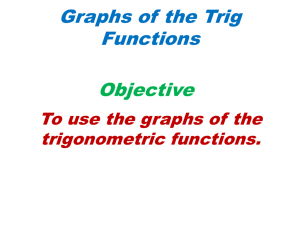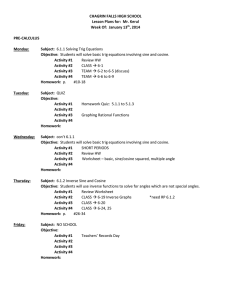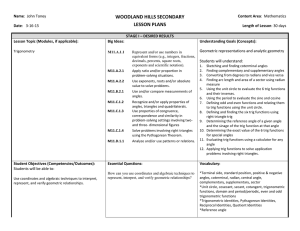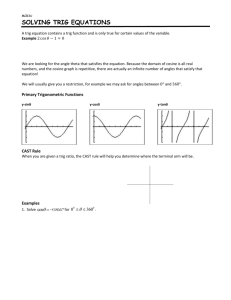WOODLAND HILLS SECONDARY LESSON PLANS
advertisement
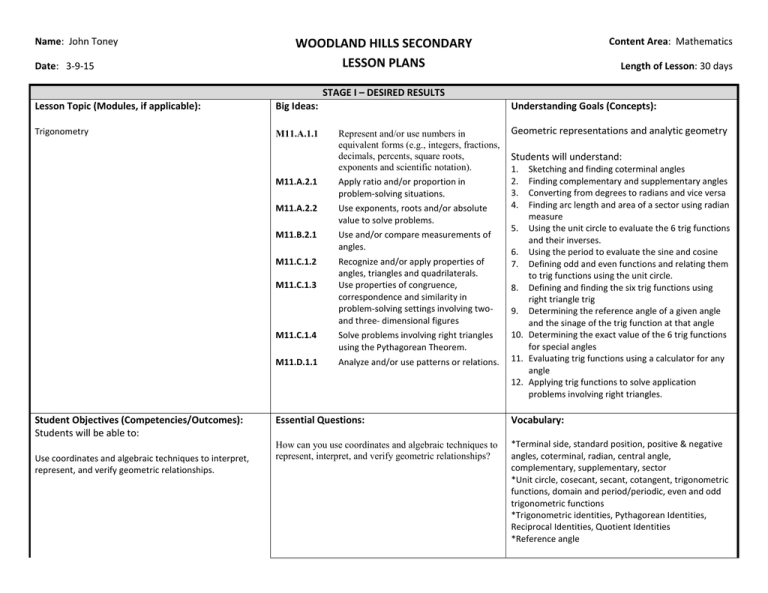
Name: John Toney Date: 3-9-15 Content Area: Mathematics WOODLAND HILLS SECONDARY LESSON PLANS Length of Lesson: 30 days STAGE I – DESIRED RESULTS Lesson Topic (Modules, if applicable): Big Ideas: Trigonometry M11.A.1.1 Use coordinates and algebraic techniques to interpret, represent, and verify geometric relationships. Represent and/or use numbers in equivalent forms (e.g., integers, fractions, decimals, percents, square roots, exponents and scientific notation). M11.A.2.1 Apply ratio and/or proportion in problem-solving situations. M11.A.2.2 Use exponents, roots and/or absolute value to solve problems. M11.B.2.1 Use and/or compare measurements of angles. M11.C.1.2 Recognize and/or apply properties of angles, triangles and quadrilaterals. Use properties of congruence, correspondence and similarity in problem-solving settings involving twoand three- dimensional figures M11.C.1.3 Student Objectives (Competencies/Outcomes): Students will be able to: Understanding Goals (Concepts): M11.C.1.4 Solve problems involving right triangles using the Pythagorean Theorem. M11.D.1.1 Analyze and/or use patterns or relations. Geometric representations and analytic geometry Students will understand: 1. 2. 3. 4. Sketching and finding coterminal angles Finding complementary and supplementary angles Converting from degrees to radians and vice versa Finding arc length and area of a sector using radian measure 5. Using the unit circle to evaluate the 6 trig functions and their inverses. 6. Using the period to evaluate the sine and cosine 7. Defining odd and even functions and relating them to trig functions using the unit circle. 8. Defining and finding the six trig functions using right triangle trig 9. Determining the reference angle of a given angle and the sinage of the trig function at that angle 10. Determining the exact value of the 6 trig functions for special angles 11. Evaluating trig functions using a calculator for any angle 12. Applying trig functions to solve application problems involving right triangles. Essential Questions: Vocabulary: How can you use coordinates and algebraic techniques to represent, interpret, and verify geometric relationships? *Terminal side, standard position, positive & negative angles, coterminal, radian, central angle, complementary, supplementary, sector *Unit circle, cosecant, secant, cotangent, trigonometric functions, domain and period/periodic, even and odd trigonometric functions *Trigonometric identities, Pythagorean Identities, Reciprocal Identities, Quotient Identities *Reference angle STAGE II – ASSESSMENT EVIDENCE Performance Task: Formative Assessments: Students will demonstrate adequate understanding via a chapter test. Pre-assessments, open-ended questions, Think-Pair-Share STAGE III – LEARNING PLAN Interventions: Flexible grouping, students will be encouraged to attend Trig Lab Materials and Resources: Textbook, notes Assignments Procedures Instructional Procedures*: Monday Date: 3/9 Day: A “Do Now” – N/A “Mini Lesson” – N/A Students will complete a multiple choice assessment on using the unit circle to evaluate the 6 trig functions, defining reference angles, evaluating trig functions using the calculator, and applying trig functions to solve application problems involving right triangles. Continue studying for the Chapter 4 OpenEnded Assessment Tuesday 3/10 Day: B “Do Now” – N/A “Mini Lesson” – N/A Students will complete an open-ended assessment on using the unit circle to evaluate the 6 trig functions, defining reference angles, evaluating trig functions using the calculator, and applying trig functions to solve application problems involving right triangles. No homework Wednesday 3/11 Day: A “Do Now” – Sketch what you think a sine and cosine graph might look like. “Mini Lesson” – Graphs of Sine and Cosine Functions Students will being studying techniques for sketching basic sine and cosine functions. They will notice why sine is odd and cosine is even, and explore the basic shapes, the domains and ranges, and key points in a period of each function. Textbook – Page 410 #31 Thursday 3/12 Day: B “Do Now” – Given a basic sine and cosine function, sketch their graphs. “Mini Lesson” – Graphs of Sine and Cosine Functions Students will explore the graphic effects of amplitude and period on sine and cosine graphs. They will discover scaling factor, and sketch graphs of sine and cosine which have vertical and/or horizontal stretching and shrinking. Textbook – Page 410 #1-14, 32, 43, 45 Friday 3/13 Day: A “Do Now” – Graph a sine function that includes a horizontal stretch, and describe why it stretched. “Mini Lesson” – Graphs of Sine and Cosine Functions Students will work on graphs of sine and cosine in which translations are applied. They will discover what causes these particular shifts. Textbook – Page 410 #37-39, 41, 49, 51 *Include Do Now, Mini Lesson, Guided Practice, Independent Practice, Summations/Formative Assessments, Reflections
